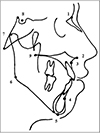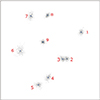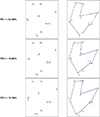1. Ramfjord SP, Ash MM. Occlusion. 3rd ed. Philadelphia: WB Saunders Co.;1982.
2. Gruenbaum T. Famous figures in dentistry mouth. JASDA. 2010; 30:18.
3. Parmesh H, Mathur VP. National Oral Health Care Program. Indian Pediatr. 2002; 39:1001–1005.
4. Katz MI. Angle’s classification revisited. Am J Orthod Dentofacial Orthop. 2007; 132:716–717.
5. McIntyre GT, Mossey PA. Size and shape measurement in contemporary cephalometrics. Eur J Orthod. 2003; 25:231–242.
6. Moyers RE, Bookstein FL. The inappropriateness of conventional cephalometrics. Am J Orthod. 1979; 75:599–617.
7. Bookstein FL. Reconsidering “The inappropriateness of conventional cephalometrics”. Am J Orthod Dentofacial Orthop. 2016; 149:784–797.
8. Halazonetis DJ. Morphometrics for cephalometric diagnosis. Am J Orthod Dentofacial Orthop. 2004; 125:571–581.
9. Rein TR, Harvati K. Geometric morphometrics and virtual anthropology: advances in human evolutionary studies. Anthropol Anz. 2014; 71:41–55.
10. Cooke SB, Terhune CE. Form, function, and geometric morphometrics. Anat Rec (Hoboken). 2015; 298:5–28.
11. Díaz Muñoz A, Soto GM. Skeletodental diagnosis using a geometric morphometric approach. Int J Odontostomat. 2014; 8:5–11.
12. Freudenthaler J, Čelar A, Ritt C, Mitteröcker P. Geometric morphometrics of different malocclusions in lateral skull radiographs. J Orofac Orthop. 2017; 78:11–20.
13. James Rohlf F, Marcus LF. A revolution morphometrics. Trends Ecol Evol. 1993; 8:129–132.
14. Krey KF, Dannhauer KH. Morphometric analysis of facial profile in adults. J Orofac Orthop. 2008; 69:424–436.
15. Mageet AO. Classification of skeletal and dental malocclusion: revisited. Stomatol Edu J. 2016; 3:38–44.
16. Wellens HL, Kuijpers-Jagtman AM, Halazonetis DJ. Geometric morphometric analysis of craniofacial variation, ontogeny and modularity in a cross-sectional sample of modern humans. J Anat. 2013; 222:397–409.
17. Dryden IL, Mardia KV. Statistical shape analysis. Chichester: Wiley;1998. p. 2716–2717.
18. Klingenberg CP. Size, shape, and form: concepts of allometry in geometric morphometrics. Dev Genes Evol. 2016; 226:113–137.
19. Enlow DH, Kuroda T, Lewis AB. The morphological and morphogenetic basis for craniofacial form and pattern. Angle Orthod. 1971; 41:161–188.
20. Franchi L, Baccetti T, McNamara JA Jr. Thin-plate spline analysis of mandibular growth. Angle Orthod. 2001; 71:83–89.
21. Moreno Uribe LM, Howe SC, Kummet C, Vela KC, Dawson DV, Southard TE. Phenotypic diversity in white adults with moderate to severe Class II malocclusion. Am J Orthod Dentofacial Orthop. 2014; 145:305–316.
22. Moreno Uribe LM, Vela KC, Kummet C, Dawson DV, Southard TE. Phenotypic diversity in white adults with moderate to severe Class III malocclusion. Am J Orthod Dentofacial Orthop. 2013; 144:32–42.
23. Proffit WR. Diagnosis and treatment planning for alveolar surgery, with special reference to soft tissue considerations. Trans Eur Orthod Soc. 1973; 604–608.
24. Iwasaki H, Ishikawa H, Chowdhury L, Nakamura S, Iida J. Properties of the ANB angle and the Wits appraisal in the skeletal estimation of Angle’s Class III patients. Eur J Orthod. 2002; 24:477–483.
25. Ghani S, Jabbar A. Correlation of ANB angle and wits appraisal in different malocclusion groups. J Pak Dent Assoc. 2013; 22:130–133.
26. Zegan G, Dascălu C, Mavru RB, Anistoroaei D. Cephalometric features of class III malocclusion. Rev Med Chir Soc Med Nat Iasi. 2015; 119:1153–1160.
27. Okşayan R, Aktan AM, Sökücü O, Haştar E, Ciftci ME. Does the panoramic radiography have the power to identify the gonial angle in orthodontics? ScientificWorldJournal. 2012; 2012:219708.
28. Mitteroecker P, Gunz P. Advances in geometric morphometrics. Evol Biol. 2009; 36:235–247.
29. Bookstein FL. Landmark methods for forms without landmarks: morphometrics of group differences in outline shape. Med Image Anal. 1997; 1:225–243.
30. Ousley SD. Forensic classification and biodistance in the 21st century: the rise of learning machines. In : Pilloud MA, Hefner JT, editors. Biological Distance Analysis: Forensic and Bioarchaeological Perstpectives. San Diego, CA: Academic Press;2016. p. 197–212.
31. Ibrahim A, Alias A, Nor FM, Swarhib M, Abu Bakar SN, Das S. Study of sexual dimorphism of Malaysian crania: an important step in identification of the skeletal remains. Anat Cell Biol. 2017; 50:86–92.




 PDF
PDF ePub
ePub Citation
Citation Print
Print















 XML Download
XML Download